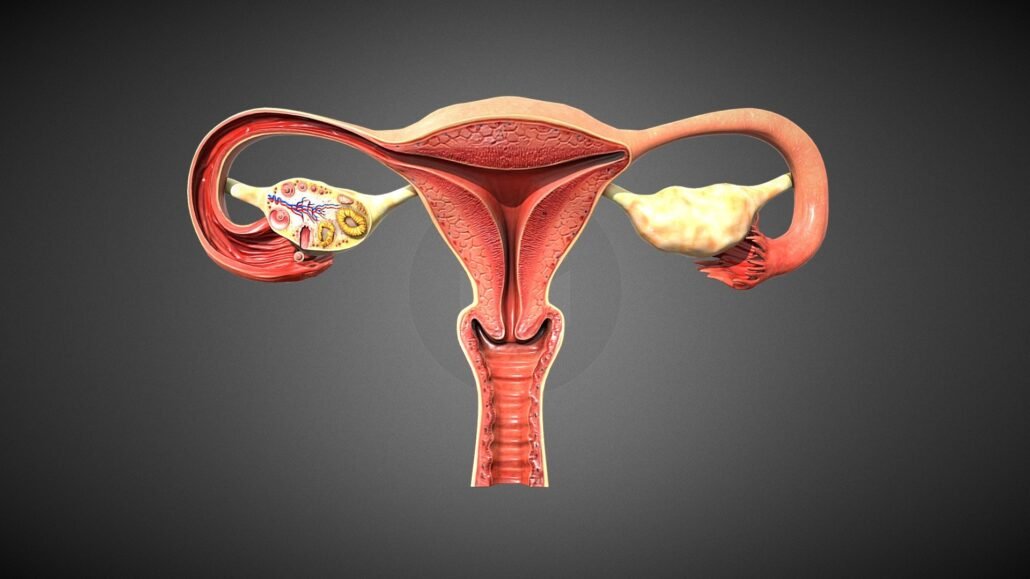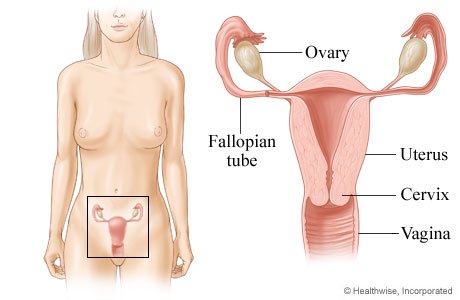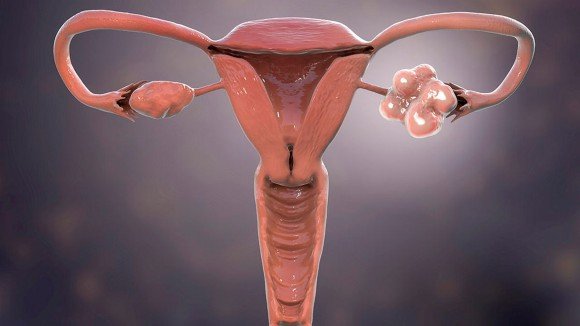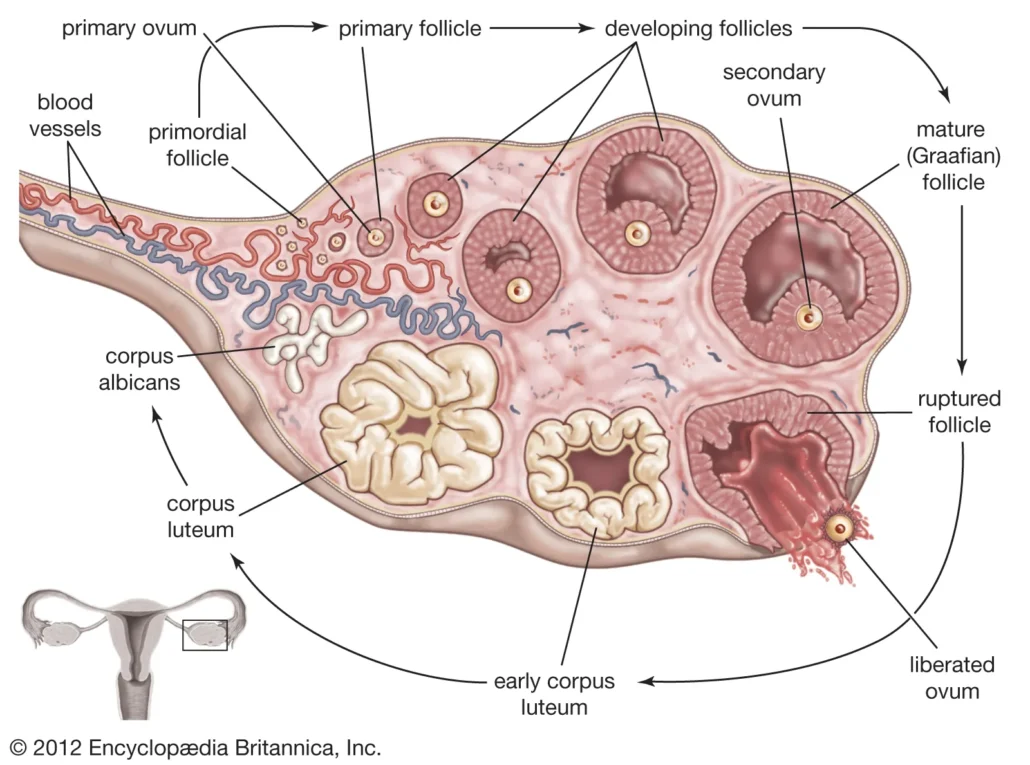Female Reproductive System


The human female reproductive system contains two main parts: the vagina and uterus, which act as the receptacle for the male’s sperm, and the ovaries, which produce the female’s ova. All of these parts are always internal; the vagina meets the outside at the vulva, which also includes the labia, clitoris and urethra. The vagina is attached to the uterus through the cervix, while the uterus is attached to the ovaries via the Fallopian tubes. At certain intervals, the ovaries release an ovum, which passes through the fallopian tube into the uterus.
If, in this transit, it meets with sperm, the sperm penetrate and merge with the egg, fertilizing it. The fertilization usually occurs in the oviducts, but can happen in the uterus itself. The zygote then implants itself in the wall of the uterus, where it begins the processes of embryogenesis and morphogenesis. When developed enough to survive outside the womb, the cervix dilates and contractions of the uterus propel the fetus through the birth canal, which is the vagina.
The ova are larger than sperm and are generally all created by birth. Approximately every month, a process of oogenesis matures one ovum to be sent down the Fallopian tube attached to its ovary in anticipation of fertilization. If not fertilized, this egg is flushed out of the system through menstruation.
Female Genital organs.
The female genital organs are classified into:
- Secondary organs: Breast (or mammary glands).
- External genital organs: Labia majora, labia minora, clitoris, hymen.
- Internal genital organs: Vagina, uterus, ovaries, fallopian tubes.
BREAST
The breasts of an adult woman are milk-producing, pear-shaped glands. They are supported by and attached to the front of the chest wall on either side of the breast bone or sternum by ligaments. They rest on the major chest muscle, the pectoralis major.
The breast has no muscle tissue. A layer of fat surrounds the glands and extends throughout the breast.
The breast is responsive to a complex interplay of hormones that cause the tissue to develop, enlarge and produce milk. The three major hormones affecting the breast are estrogen, progesterone and prolactin, which cause glandular tissue in the breast and the uterus to change during the menstrual cycle.
Each breast contains 15 to 20 lobes arranged in a circular fashion. The fat (subcutaneous adipose tissue) that covers the lobes gives the breast its size and shape. Each lobe is comprised of many lobules, at the end of which are tiny bulb like glands, or sacs, where milk is produced in response to hormonal signals.
Ducts connect the lobes, lobules, and glands in nursing mothers. These ducts deliver milk to openings in the nipple. The areola is the darker-pigmented area around the nipple.
External Genital Organs: These organs are collectively known as vulva and it consists of the following parts:
- Labia majora: They are two round and thick folds of skin, which from the sides of vulva.
- Labia minora (nymphae): They are two thin folds of skin, which lie in the space enclosed by labia majora. Vestibule is a triangular area, which is enclosed by labia minora. The vestibule contains the openings of urethra and vagina.
- Clitoris: It is a small erectile body situated at the apex of the vestibule. It is highly sensitive structure.
- Hymen: It is a thin membrane which covers the vaginal orifice of virgin women. It is usually perforated so as to allow menstrual flow.
Internal Genital Organs:
Vagina: It extends from the exterior of the body (vaginal orifice) below to the cervix of uterus above. The vagina is lined by a thin skin, which is thrown into a number of folds. Bartholin’s glands are two small, rounded glands on either side of vaginal orifice. They produce mucus secretion which lubricates the vagina.
Uterus consists of three parts:
- Fundus: Fundus is the upper part which lies above the two openings of fallopian tube.
- Body: Body is the part which lies between the fundus and cervix.
- Cervix: Cervix is the lower constructed part. The cervix is continuous above with the body of uterus through an orifice called internal os. It is continuous below with the vagina through external os.
Fallopian tubes are attached on either side of the fundus of uterus. The uterus is supported and held in position by means of ligaments. They are
- Two broad ligaments.
- Two round ligaments which extend from the uterus (below the fallopian tube) to labia majora.
The walls of the uterus are thick and consist of three layers. They are
- Outer peritoneal layer called perimetrium.
- Middle muscular layer called myometrium.
- Inner layer called endometrium.
Ovaries


Ovaries are oval shaped and, in the human, measure approximately 3 cm x 1.5 cm x 1.5 cm. The ovary (for a given side) is located in the lateral wall of the pelvis in a region called the ovarian fossa. The fossa usually lies beneath the external iliac artery and in front of the ureter and the internal iliac artery.
In the human the paired ovaries lie within the pelvic cavity, on either side of the uterus, to which they are attached via a fibrous cord called the ovarian ligament. The ovaries are uncovered in the peritoneal cavity but are tethered to the body wall via the suspensory ligament of the ovary. The part of the broad ligament of the uterus that covers the ovary is known as the mesovarium.
Fallopian tubes (uterine tubes): The fallopian tubes are two in number. They arise, one on each side, from the upper angles of the uterus. They lie in the upper margin of the broad ligament of uterus.
The fallopian tube has the following parts:
- A uterine end: The uterine end is attached to the walls of uterus. The opening at this end continues with the cavity of uterus.
- An ampulla: The ampulla is a slight enlargement near the fimbrial end.
- A fimbrial end: The fimbrial end is the terminal portion of fallopian tube. This end has:
- Finger like processes called fimbriae.
- An opening, which gives access to the peritoneal cavity.
The fallopian tube acts as a passage for ova from the ovary to the uterus. Usually, the fertilization of ovum by spermatozoa occurs in the fallopian tube.
Ovulation:
Ovulation occurs when a mature egg is released from the ovary, pushed down the fallopian tube, and is available to be fertilized. The lining of the uterus has thickened to prepare for a fertilized egg. If no conception occurs, the uterine lining as well as blood will be shed. The shedding of an unfertilized egg and the uterine wall is the time of menstruation
Key Facts of Ovulation:
- An egg lives 12-24 hours after leaving the ovary
- Normally only one egg is released each time of ovulation
- Ovulation can be affected by stress, illness or disruption of normal routines
- Some women may experience some light blood spotting during ovulation
- Implantation of a fertilized egg normally takes place 6-12 days after ovulation
- Each woman is born with millions of immature eggs that are awaiting ovulation to begin
- A menstrual period can occur even if ovulation has not occurred
- Ovulation can occur even if a menstrual period has not occurred
- Some women can feel a bit of pain or aching near the ovaries during ovulation called mittelschmerz, which means “middle pain” in German
- If an egg is not fertilized, it disintegrates and is absorbed into the uterine lining
Ovulation occurs around the 14th day of menstrual cycle. The ovum is discharged into the peritoneal cavity. It is carried to the fallopian tube by the action of fimbriae. The ovum gets fertilized in the fallopian tube and later gets embedded in the uterine wall. If the ovum is not fertilized it is discharged through menstrual flow.
Menstruation: Menstruation starts at puberty. It stops temporarily during pregnancy but permanently at menopause. It occurs almost every 28 days. Menstruation involves periodic discharge of blood from uterine cavity. During menstrual cycle, the endometrium undergoes cyclic changes and is prepared to receive the fertilized ovum.
Contraceptive methods: These are preventive methods to help woman avoid unwanted pregnancies. They include temporary and permanent measures to prevent pregnancy resulting from coitus. Various methods are:
- Intrauterine devices.
- Hormonal methods or oral contraception pills.
- Male sterilization (Vasectomy).
- Female sterilization (Tubectomy).
Pregnancy:
When fertilization occurs, the fertilized ovum travels from the fallopian tube and implants in the uterine endometrium. Now a vascular organ called placenta is developed from fetus and maternal endometrium, major part contributed by fetus. The outermost membrane of the placenta is called chorion and the innermost amnion which holds the fetus in the amniotic cavity and is filled with amniotic fluid. Placenta, attached to the uterine wall, established the connection between the mother and the fetus through the umbilical cord. Placenta secretes a hormone called HCG (human chorionic gonadotropin). HCG is tested for the urine of women who suspect that they are pregnant.
Fetus:
The unborn offspring from the end of the 8th week after conception (when the major structures have formed) until birth. Up until the eighth week, the developing offspring is called an embryo.
Fetus lies inside the uterus in a closed cavity filled with amniotic fluid, the following terms are in use to describe the position of the fetus.
Presentation:
The part of the fetus that occupies the lower end of the uterus. Accordingly the presentation may be cephalic, breech or shoulder.
Labor (Parturition):
Labor is a process during which the fetus is expelled out through vagina due to the contraction of the upper segment of uterus and relaxation of the lower segment uterus.
Labor is divided into three stages:
I stage extends from onset of true labor pain to dilation of cervix
II stage extends from complete dilation of cervix to expulsion of fetus.
III stage extends from expulsion of fetus to expulsion of placenta.
Pregnancy:
Gravida: The term gravida, followed by a number denotes the total no of pregnancies including the present one. It includes ectopic abortions and normal pregnancies.
Para: The term para, followed by a number denotes the number of deliveries after the 20th week of gestation.
Pathological conditions
- Menorrhagia: Menstrual, cycle is unaltered but the duration of menstrual bleeding of its quality is increased.
- Polymenorrhea: Occurrence of menstrual cycles of greater than usual frequency.
- Menorrhagia: Irregular bleeding which is taking place in between menses.
- Dysmenorrhea: Painful menstruation is called dysmenorrhea.
- Dyspareunia: pain or difficulty with intercourse. This is usually associated with inflammatory lesions at the vaginal introitus or in the vaginal canal.
- Vaginal discharge: Based on color, duration, whether or not it is offensive and blood stained different etiological factors can be ruled out.
Bartholin’s cyst:
Results from inflammatory occlusion of the ducts of Bartholin’s glands. Gonorrheal and other infections cause inflammatory obstruction. Management is by antibiotic therapy and excision.
Condyloma acuminatum:
A contagious projecting warty growth on the external genitals or at the anus, consisting of fibrous overgrowths covered by thickened epithelium showing koilocytosis, due to sexual contact with infection by human papilloma virus; it is usually benign, although malignant change has been reported, associated with particular types of the virus.
Pelvic Inflammatory disease:
Pelvic inflammatory disease (or disorder) (PID) is a generic term for inflammation of the female uterus, fallopian tubes, and/or ovaries as it progresses to scar formation with adhesions to nearby tissues and organs. This may lead to tissue necrosis with/or without abscess formation. Pus can be released into the peritoneum. Two thirds of patients with laparoscopic evidence of previous PID were not aware they had had PID. PID is often associated with sexually transmitted diseases, as it is a common result of such infections. PID is a vague term and can refer to viral, fungal, parasitic, though most often bacterial infections. PID should be classified by affected organs, the stage of the infection, and the organism(s) causing it. Although an STD is often the cause, other routes are possible, including lymphatic, postpartum, postabortal (either miscarriage or abortion) or intrauterine device (IUD) related, and hematogenous spread.
Cervicitis:
Chronic inflammation of the cervix. Cervicitis may be acute or chronic. Cervicitis may follow infection with gonorrhea or Chlamydia, but many infections are non-specific. The mucus membranes of the cervix are not shed off as in endometrium every month so the infection tends to become chronic. Clinical features include mucus or muco-purulent discharge. White discharge (leukorrhea), chronic back pain and low abdominal pain. Treatment includes cauterization and antibiotic therapy.
Carcinoma of cervix:
Malignant cancer of the cervix or cervical area. It may present with vaginal bleeding but symptoms may be absent until the cancer is in its advanced stages, which has made cervical cancer the focus of intense screening efforts using the Pap smear. In developed countries, the widespread use of cervical screening programs has reduced the incidence of invasive cervical cancer by 50% or more.
Endometriosis:
It is the presence of endometrial tissue in abnormal location outside the uterus. This condition involves the ovaries, uterine ligaments, pelvic peritoneum, and small intestine. When the ovaries are involved, large blood-filled cysts, called chocolate cysts may develop. Endometriosis presents clinically as severe dysmenorrheal and pelvic pain and is a common cause for female infertility. Treatment includes symptomatic relief of pain, drugs to regulate menstrual cycle and surgical removal of endometrial tissue.
Dysfunctional uterine bleeding:
Excessive bleeding during or between menstrual periods in the absence of an organic lesion. The causes of abnormal bleeding are many and vary in different age groups. Treatment includes hormones (estrogen, combined oral pill), NSAIDs and surgery (curettage).
Leiomyoma (Fibroids): Most common benign tumors in women. They are composed of benign masses of smooth muscle cells. There are three types of fibroids:
- Intramural (within the myometrium)
- Subserosal (beneath the serosa)
- Submucosal (beneath the endometrium).
The symptoms are menorrhagia, dysmenorrheal pelvic pain. Treatment includes hysterectomy.
Endometrial carcinoma
Endometrial cancer refers to several types of malignancy which arise from the endometrium, or lining of the uterus. Endometrial cancers are the most common gynecologic cancers in the United States, with over 35,000 women diagnosed each year in the U.S. The most common subtype, endometrioid adenocarcinoma, typically occurs within a few decades of menopause, is associated with excessive estrogen exposure, often develops in the setting of endometrial hyperplasia, and presents most often with vaginal bleeding. Endometrial carcinoma is the third most common cause of gynecologic cancer death (behind ovarian and cervical cancer). A total abdominal hysterectomy (surgical removal of the uterus) with bilateral salpingo-oophorectomy is the most common therapeutic approach.
Carcinoma of the breast
Breast cancer is a cancer that starts in the cells of the breast. Worldwide, breast cancer is the second most common type of cancer (10.4%; after lung cancer) and the fifth most common cause of cancer death (after lung cancer, stomach cancer, liver cancer, and colon cancer). Among women worldwide, breast cancer is the most common cause of cancer death. In 2005, breast cancer caused 502,000 deaths worldwide (7% of cancer deaths; almost 1% of all deaths). The number of cases worldwide has significantly increased since the 1970s, a phenomenon partly blamed on modern lifestyles in the Western world.
It spreads through lymphatic vessels to the axillary lymph glands. It may also spread to other body organs like the bone, liver, lungs and brain. Treatment includes surgery, chemotherapy and hormone therapy.
Ovarian cyst: Collection of fluid within a sac in the ovary. Some cysts are lined by normal epithelial cells of the ovary. These include
- Follicular cyst: It is the result of failure of absorption of fluid in the graffian follicle.
- Luteal cyst: It is the result of ruptured but immediately sealed off graffian follicle.
Ovarian carcinoma
Malignant tumor of the ovary. Based on its consistency it may be cystic or solid. The tumor is usually discovered in an advanced stage as an abdominal mass and produces few symptoms in the early stages. In most cases it metastasizes beyond the pelvic region. Surgery, radiotherapy, chemotherapy are the treatment measures.
Ectopic Pregnancy
Implantation of embryo in any other site other than the uterus is called ectopic pregnancy. Most commonly it occurs in the fallopian tubes and rarely in the ovary or in the abdominal cavity. Predisposing factors include PID with chronic salphingitis.
The outcome of ectopic pregnancy includes:
Hematosalpinx- Rupture with the fallopian tube leading to accumulation of blood.
Intraperitoneal hemorrhage – when the fallopian tube completely ruptures.
Laboratory tests and clinical procedures:
Laparoscopy: Visual examination of abdomen by making an incision below the umbilicus and introducing a laparoscope. This procedure is used for both diagnostic and therapeutic purposes.
Hysteroscopy: It is an endoscopic technique permitting direct viewing of the interior of the uterine cavity for diagnostic and therapeutic purposes.
Culdoscopy: Culdoscope is endoscope introduced in to the peritoneal cavity through the pouch of Douglas. The sites inspected include pouch of Douglas, posterior surfaces of the uterus and adnexa.
Colposcopy: Colposcope is used to inspect the cervix and vagina. The purpose of colposcopy is to detect abnormal areas so that sensitive biopsy can be done under magnification.
Amniocentesis: Puncture of the amniotic fluid sac and withdrawal of the amniotic fluid. This procedure is helpful for antenatal diagnosis of chromosomal and genetic disorders, fetal maturity.
Pap smear: A spatula is used to drape the outer lining of the cervix. Microscopic analysis of the cell smear (spread on slide) can detect the presence of cervical or vaginal carcinoma.
Hysterosalpingogram: A radio opaque dye is injected into the uterus and fallopian tubes via vagina and recording of the uterus and fallopian tubes is performed.
ABBREVIATIONS
AB : Abortion
AFP : :Alpha-fetoproein
C-Section : Cesarean section
CIS : Carcinoma in situ
Cx : Cervix
D&C : Dilation and curettage
DES : Diethylstibestrol
DUB : Dysfunctional uterine bleeding
ECC : Endocervical curettage
EMB : Endometrial biopsy
ERT : Estrogen replacement therapy
FHT : Fetal heart tones
FSH : Follicle stimulating hormone
G : Gravida
HSG : Hysterosalpingography
HCG/hcg : Human chorionic gonadotropin
IUP : Intrauterine pregnancy
IUD : Intrauterine device
LH : Leutinizing hormone
LMP : Last menstrual period
OB : Obstetrics
OCPs : Oral contraceptive pills
Pap smear : Papamcolaous smear
Path : Pathology
Peds : Pediatrics
PID : Pelvic inflammatory disease
PMS : Premenstrual syndrome
TAH-BSO : Total abdominal hysterectomy with bilateral salpingo-oophorectomy
UC : Uterine contractions

